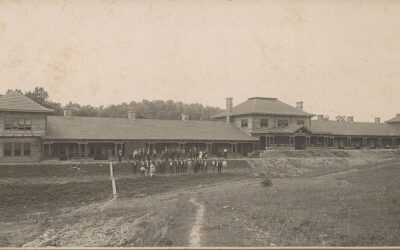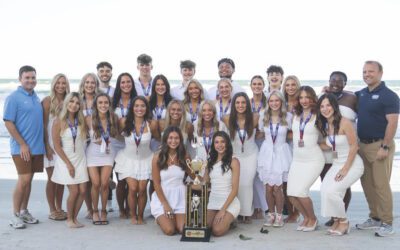[title subtitle=”WORDS Dwain Hebda
IMAGES courtesy Rodney Steele and Hope and Cave City Festival Organizers”][/title]
Arkansas is a land largely unmarred by military conflict, save one: the Civil War Battle at Pea Ridge. Fought in the northwest corner of the state over three days in 1862, it cost nearly four thousand lives with Confederate dead outnumbering those of the Union by a thousand.
It’s not only the lone major battle fought in The Natural State, it’s the only one that comes close to the passion and ferocity with which residents of Cave City and Hope have defended their respective claims as the globe’s top spot for watermelons through the years.
To be fair, both sides admit there’s a difference in their titles – Hope claims the World’s Largest Watermelon and Cave City the World’s Sweetest – and that has managed to maintain the détente between the two communities, which sit roughly diagonal to each other in the northeast and southwest corners of the state.
“Well, you know, I’m going to be a typical politician, though I’m not a politician,” says Julie Johnson, chairperson of the Cave City Watermelon Festival. “I think Arkansas is plenty big enough to have two watermelon festivals.
“We are the home of the world’s sweetest watermelons and Hope is the home of the world’s largest watermelons. So, it’s just apples and oranges. You can’t really compare. Ours are sweeter. Theirs are bigger.”
“There’s something in the soil, whether it’s in Hope or Cave City, that’s the key,” says Beckie Moore, executive director with the Hope Hempstead County Chamber of Commerce. “We’re home to a wonderful family, the Bright family, where watermelon history runs deep. Anytime you hear the Bright family is coming to a growing contest, you know they’re going to win.”
Such pleasantries have been hard-won; if there were ever any tensions between the two towns over the question of whose melons are best, they quickly faded last year when both were forced to cancel their summertime festivals due to covid-19. The loss of tourism dollars and a piece of town heritage – neither had ever canceled their festivals before – was a pain the two communities held in common.
“It was the only year it was canceled, and it was devastating to the committee, to the chamber board of directors and all those that made the decision, as well as to Hope and Hempstead County,” Julie says. “2020 was difficult.”
Happily, festivalgoers and vendors have missed the events as much as city officials. Cave City attracted about fifteen thousand guests in 2019 and Hope about twenty thousand. Both organizers say all signs point to a 2021 attendance that’s well beyond that after a year away.
Julie says as with many good feuds, the combatants in this debate have far more in common than what separates them and that’s a desire to keep tradition alive. Watermelons are a big part of civic pride as well as a keystone of the local economy, she said.
“We’re both relatively small communities,” she says. “I spent a lot of time on the phone with the organizers of the Hope festival last year. You know, we were commiserating with each other and trying to figure out what to do. We really do want the best for each other.”
Still, with all current niceties and semantics, both towns have gone to great lengths to substantiate their melon-related claims. In that effort, they have shown they’re not above a little gamesmanship.
“This has been proven scientifically; there is sandy soil in this area, and it just grows sweeter watermelons,” Julie says. “Here a few years ago, the people who were running the festival had somebody come from, I don’t know if it was the University of Arkansas, I honestly can’t remember. They had this device that measured the sweetness of watermelons and ours had a higher sugar content than the ones in Hope.
“We’ll have people drive from Chicago just to get our watermelons; they come from Dallas, they come from Missouri. They’ll make a trip and they’ll come and get twenty, thirty, forty watermelons, whatever they can haul.”
All well and good, Beckie counters, while pointing out Hope has endorsements and pedigree of its own.
“Ivan Bright, the patriarch of the Bright family, planted watermelons years ago,” she says. “He has a Guinness world record for the largest watermelon grown and his son took that over. Hope watermelons are in the Guinness Book of World Records three times, the last record was 268.8 pounds.
“That’s another thing; tourists are always shocked when we say ‘Oh we have small melons this year. They’re only 100 pounds.’ That’s just something that we can boast about.”
What is not in dispute is Hope’s festival dates back far longer than the Cave City version. Hope’s Chamber of Commerce started cashing in on the mammoth fruit beginning in the mid-1920s with one-day affairs that consisted of a parade, a Watermelon Queen pageant and serving ice-cold watermelon to train passengers. Twenty thousand people would routinely attend, causing the event to collapse under its own weight during the Great Depression.
More than four decades later, Hope celebrated its centennial to great fanfare in 1975 leading city officials to search around for ideas for an annual festival.
“A wonderful gentleman named Pod Rogers worked for the Hope Star [newspaper] and he thought it was time to resurrect the watermelon festival, which looks similar to what we do today, a full-blown festival,” Beckie says
The revived Hope event was gaining steam when Cave City decided to try their hand at their own event in 1980. It was an inauspicious debut as an exceptionally dry growing season caused a low yield and shortage of the very fruit the event was built to promote. Had local grower Herschel Runsick not planted his melons in the Strawberry River bottoms that year, the festival might have suffered the irreparable indignity of not having had enough namesake produce for the inaugural watermelon feast.
But survive it did and with it the long-simmering debate over the epicenter of watermelon greatness in Arkansas with its attendant acrimony. For a spell, the two festivals refused to budge from scheduling the same weekend just to tweak the nose of the other. In the 1990s, Hope got a lot of mileage out of native son Bill Clinton’s Hope homeplace and used that notoriety to plug the festival.
Cave City, meanwhile, has for years generated annual summertime headlines warning the public about unscrupulous third-party vendors passing off counterfeit Cave City product. This has led to growers applying a sticker certifying the authenticity of their melons that, while extra work and expense, brings a measure of satisfaction, too. After all, they reason, no one ever tries to copy the second-best of anything.
All in good fun, Julie insists, with much of the so-called feuding a charade to drive interest, like two heavyweight boxers pumping up a title fight.
“They just want the best for their community, like we do,” Beckie says. “We want people to know about our product. We take a lot of pride in our product and if us picking back and forth at each other kind of stirs the pot and gets people talking, that’s good. That’s okay.
“We’re both relatively small communities and we want the best for each other. It is all in good fun.” She pauses, then adds with a grin. “Well, I’m not certain that it has always been in good fun.”
Cave City Watermelon Festival
July 29-31
cavecitywatermelonfestival.com
- Free entertainment, capped by country star Tracy Byrd headlining on Saturday
- 5K run
- Kiwanis pancake breakfast
- Parade and car show
- Free watermelon feast sponsored by local growers
- Craft and food vendors
Hope Watermelon Festival
August 5-7
hopewatermelonfest.com
- Musical and talent entertainment throughout the weekend, headlined by Phil Vassar
- Axe throwing contest
- Camel and pony rides, petting zoo
- Watermelon eating and seed-spitting contests
- Antique and classic car and antique engine shows
- Watermelon Olympics




